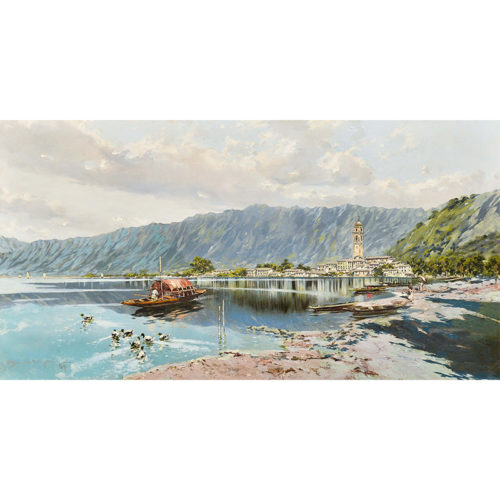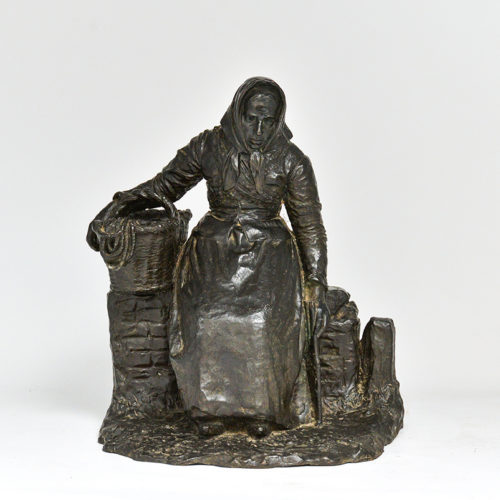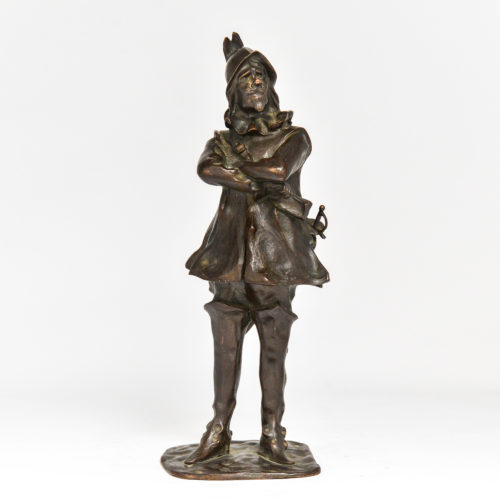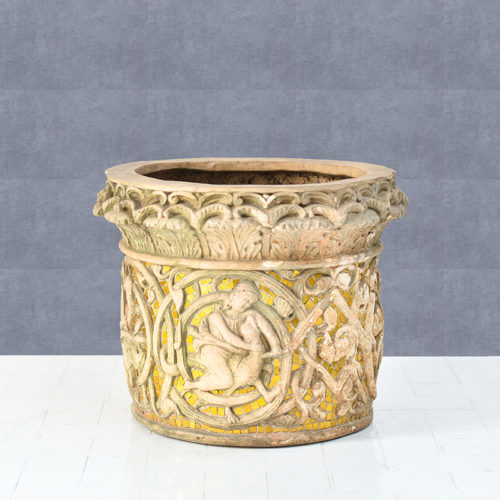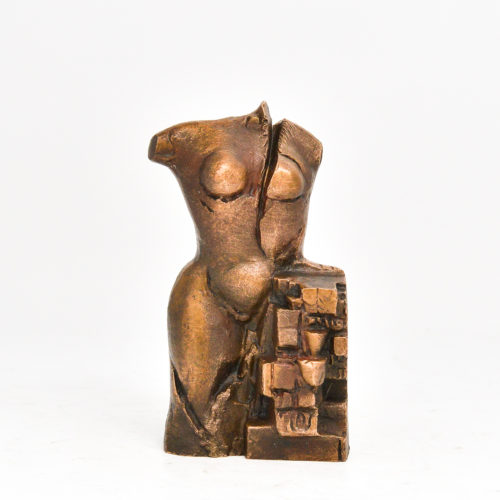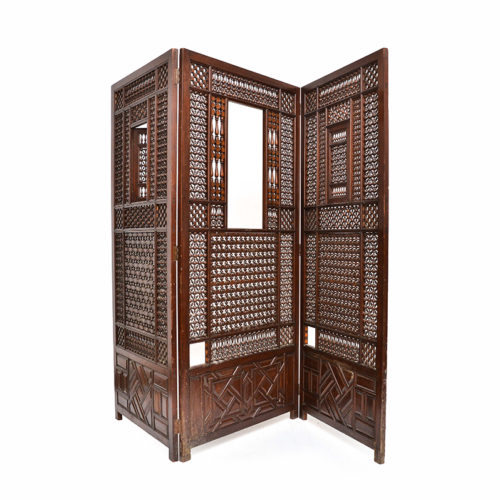"Lago Maggiore" - Large oil painting on canvas by Riccardo Pellegrini (1863-1934), depicting a landscape on the shores of Lake Maggiore. Restored, with coeval frame.
PELLEGRINI RICCARDO. Born in Milan on 11 March 1863, died in Crescenzago (Mi) on 31 March 1934. He studied in his city, then in Rome, and in Naples with Domenico Morelli. He travelled to Spain, England and France to deepen his artistic knowledge. In 1912 he won the Muller house competition in London for the illustrations of the Gil Blas of Le Sage. Then the illustrations for "Don Quixote" were commissioned. The main magazines in Europe collaborated with him. He rarely exhibited in Italy, but when he did it had always success. His sketch Malta is located in the Berlin Art Museum; La ridda, in the Gofort Museum in Stuttgart; The kiss of sun, in the Goupil Gallery in Paris. The drawings made for the "Gil Blas" were collected in a room dedicated to the Pilgrims in the Glasgow Museum. The Bottega di Poesia exhibition held in Milan in 1926 featured: A carpet market in Spain; Winter quiet; Sun of July; One August morning in Toledo; Valencian Sea; The spouses. Other works: Spanish flower market, in the R.O. collection of Rome, one of his best works; Villereccia party, in the Rovelli collection of Milan; The antiquarian, in the Ruffini collection in Milan; In the market (Xeres); Sur la promenade des Anglais; Notes of Spain; Remembrance of Seville; I remember my country; El picador; El primer espada; View of Seville; Spanish types; A bullfighter.
-
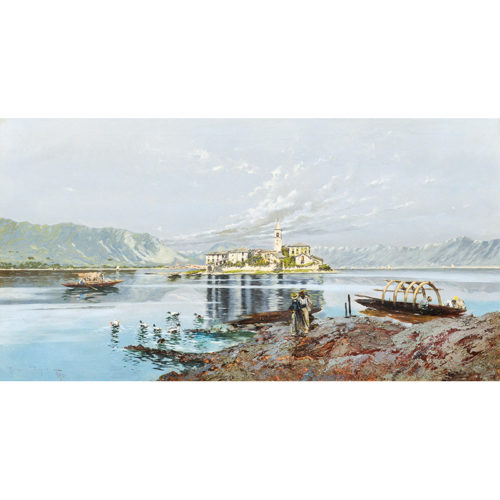 Period: 1896 Measurements: In frame H 87 x L 143 / Canvas H 65 x L 121 cm"Lake Maggiore" - Large oil painting on canvas by Riccardo Pellegrini (1863-1934), depicting the Fishermen's Island seen from a coast. Restored, with contemporary frames. PELLEGRINI RICCARDO. Born in Milan on 11 March 1863, died in Crescenzago (Mi) on 31 March 1934. He studied in his city, then in Rome, and in Naples with Domenico Morelli. He travelled to Spain, England and France to deepen his artistic knowledge. In 1912 he won the Muller house competition in London for the illustrations of the Gil Blas of Le Sage. Then the illustrations for "Don Quixote" were commissioned. The main magazines in Europe collaborated with him. He rarely exhibited in Italy, but always with success. His sketch Malta is located in the Berlin Art Museum; La ridda, in the Gofort Museum in Stuttgart; The kiss of sun, in the Goupil Gallery in Paris. The drawings made for the "Gil Blas" were collected in a room dedicated to the Pilgrims in the Glasgow Museum. The Bottega di Poesia exhibition held in Milan in 1926 featured: A carpet market in Spain; Winter quiet; Sun of July; One August morning in Toledo; Valencian Sea; The spouses. Other works: Spanish flower market, in the R.O. collection of Rome, one of his best works; Villereccia party, in the Rovelli collection of Milan; The antiquarian, in the Ruffini collection in Milan; In the market (Xeres); Sur la promenade des Anglais; Notes of Spain; Remembrance of Seville; I remember my country; El picador; El primer espada; View of Seville; Spanish types; A bullfighter.
Period: 1896 Measurements: In frame H 87 x L 143 / Canvas H 65 x L 121 cm"Lake Maggiore" - Large oil painting on canvas by Riccardo Pellegrini (1863-1934), depicting the Fishermen's Island seen from a coast. Restored, with contemporary frames. PELLEGRINI RICCARDO. Born in Milan on 11 March 1863, died in Crescenzago (Mi) on 31 March 1934. He studied in his city, then in Rome, and in Naples with Domenico Morelli. He travelled to Spain, England and France to deepen his artistic knowledge. In 1912 he won the Muller house competition in London for the illustrations of the Gil Blas of Le Sage. Then the illustrations for "Don Quixote" were commissioned. The main magazines in Europe collaborated with him. He rarely exhibited in Italy, but always with success. His sketch Malta is located in the Berlin Art Museum; La ridda, in the Gofort Museum in Stuttgart; The kiss of sun, in the Goupil Gallery in Paris. The drawings made for the "Gil Blas" were collected in a room dedicated to the Pilgrims in the Glasgow Museum. The Bottega di Poesia exhibition held in Milan in 1926 featured: A carpet market in Spain; Winter quiet; Sun of July; One August morning in Toledo; Valencian Sea; The spouses. Other works: Spanish flower market, in the R.O. collection of Rome, one of his best works; Villereccia party, in the Rovelli collection of Milan; The antiquarian, in the Ruffini collection in Milan; In the market (Xeres); Sur la promenade des Anglais; Notes of Spain; Remembrance of Seville; I remember my country; El picador; El primer espada; View of Seville; Spanish types; A bullfighter. -
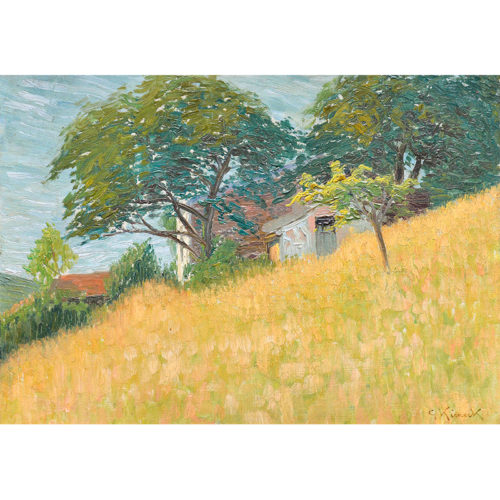 Period: 30s / 40s Measures: H 44 x L 55 x P 6 / Tablet H 26 x L 35 cm"Landscape" - Oil on tablet by Giorgio Kienerk (1869-1948). Signed on the lower right. The work was already sold in Martini auction in December 2011. KIENERK GIORGIO. He was born in Florence, in an ancient Tuscan family, on May 5, 1869. He studied with Adriano Cecioni, then, recommended by Telemaco Signorini, he dedicated himself not only to sculpture but also to painting. He formed, therefore, alongside Macchiaioli and made his debut very early, exhibiting six small landscapes at the Promotrice of Florence in 1888. He continued annually to present paintings and statues there. From 1891 to 1895 he followed the Divisionist school and painted, among other things, In riva all'Arno and Mattino sul mare. In 1897 he exhibited two large pastel female portraits at the Internationale of art and flowers in Florence and then oriented himself towards large figures, often with an allegorical meaning. In 1898 he appeared in Turin with Dolore. Then he participated in the Venetian Biennials with La vergognosa (1899), Il Silenza (1901), the Portrait of Irma Gramatica, pastel (1903), Sera, drawing (1905). He then came to the main Italian and foreign exhibitions in Brussels, Munich, Vienna, London, Saint Louis, Buenos Aires. With his scratched, borderless drawings, he has collaborated in magazines and newspapers (La Fiammetta, No-vissima, L'Italia ride, La Domenica dell'Avanti, La Liguria ligure, Numero, Gil Blas and Cocoricò dì Parigi). In 1905 he was appointed director of the civic painting school of Pavia. In the early period Pavia was particularly interested in sculpture, especially bronze plaques, a genre that he cultivated for a long time. After 1913, thanks to the experience acquired with the studies on Divisionism and mindful of the research of colors and light of the early years, he returned to deal with landscape and from then until his death the campaign was a continuous source of inspiration, especially after 1920 when he started working in Fauglia, on the Pisan hills (The washerwomen, Under the olive tree, In the shadow of the Carob tree, Dusty road). The portraits also belong to his last production (Portrait of the Marquis Quaratesi). In 1922 he exhibited in Florence at the Fiorentina Spring and until 1936 several times in Pavia. In 1936, finishing his teaching at the school of painting, many works were purchased by the Municipality of Pavia and are located in the museum of that city. From 1937 to 1943 he lived in Florence, exhibiting in various solo shows in Florence itself and also in Lucca and Livorno. In 1947 an exhibition of his works was opened at the Galleria Geri in Milan. Retiring to Fauglia with his family in 1943, he died in his villa in Poggio alla Farnia on February 15, 1948. His works can be found in the Modern Art Galleries of Venice, Florence, Lima (Peru) and in the Museum of Brussels. Many are in private collections in Pavia, Milan, where in the Turri Collection there is a Girl's Head, in Genoa, Florence. He engraved some drypoint plates.
Period: 30s / 40s Measures: H 44 x L 55 x P 6 / Tablet H 26 x L 35 cm"Landscape" - Oil on tablet by Giorgio Kienerk (1869-1948). Signed on the lower right. The work was already sold in Martini auction in December 2011. KIENERK GIORGIO. He was born in Florence, in an ancient Tuscan family, on May 5, 1869. He studied with Adriano Cecioni, then, recommended by Telemaco Signorini, he dedicated himself not only to sculpture but also to painting. He formed, therefore, alongside Macchiaioli and made his debut very early, exhibiting six small landscapes at the Promotrice of Florence in 1888. He continued annually to present paintings and statues there. From 1891 to 1895 he followed the Divisionist school and painted, among other things, In riva all'Arno and Mattino sul mare. In 1897 he exhibited two large pastel female portraits at the Internationale of art and flowers in Florence and then oriented himself towards large figures, often with an allegorical meaning. In 1898 he appeared in Turin with Dolore. Then he participated in the Venetian Biennials with La vergognosa (1899), Il Silenza (1901), the Portrait of Irma Gramatica, pastel (1903), Sera, drawing (1905). He then came to the main Italian and foreign exhibitions in Brussels, Munich, Vienna, London, Saint Louis, Buenos Aires. With his scratched, borderless drawings, he has collaborated in magazines and newspapers (La Fiammetta, No-vissima, L'Italia ride, La Domenica dell'Avanti, La Liguria ligure, Numero, Gil Blas and Cocoricò dì Parigi). In 1905 he was appointed director of the civic painting school of Pavia. In the early period Pavia was particularly interested in sculpture, especially bronze plaques, a genre that he cultivated for a long time. After 1913, thanks to the experience acquired with the studies on Divisionism and mindful of the research of colors and light of the early years, he returned to deal with landscape and from then until his death the campaign was a continuous source of inspiration, especially after 1920 when he started working in Fauglia, on the Pisan hills (The washerwomen, Under the olive tree, In the shadow of the Carob tree, Dusty road). The portraits also belong to his last production (Portrait of the Marquis Quaratesi). In 1922 he exhibited in Florence at the Fiorentina Spring and until 1936 several times in Pavia. In 1936, finishing his teaching at the school of painting, many works were purchased by the Municipality of Pavia and are located in the museum of that city. From 1937 to 1943 he lived in Florence, exhibiting in various solo shows in Florence itself and also in Lucca and Livorno. In 1947 an exhibition of his works was opened at the Galleria Geri in Milan. Retiring to Fauglia with his family in 1943, he died in his villa in Poggio alla Farnia on February 15, 1948. His works can be found in the Modern Art Galleries of Venice, Florence, Lima (Peru) and in the Museum of Brussels. Many are in private collections in Pavia, Milan, where in the Turri Collection there is a Girl's Head, in Genoa, Florence. He engraved some drypoint plates. -
Out of stock
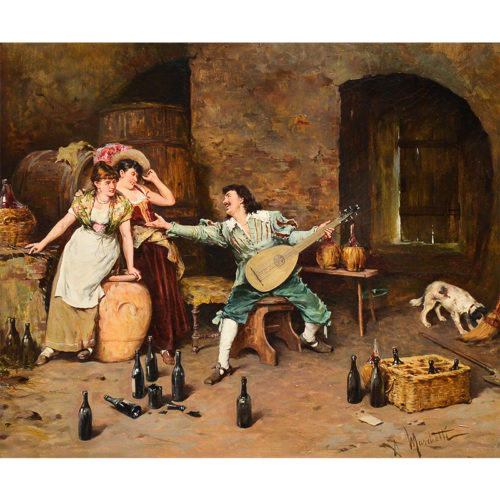 Period: Late 19th century Measures: In frame H 74 x L 85 x P 9 / Canvas H 50 x L 60 cm"Interior scene with characters" - Oil on canvas, signed on the lower right corner "Marchetti", dating back to the end of the 19th century, of beautiful quality and definition.
Period: Late 19th century Measures: In frame H 74 x L 85 x P 9 / Canvas H 50 x L 60 cm"Interior scene with characters" - Oil on canvas, signed on the lower right corner "Marchetti", dating back to the end of the 19th century, of beautiful quality and definition. -
Out of stock
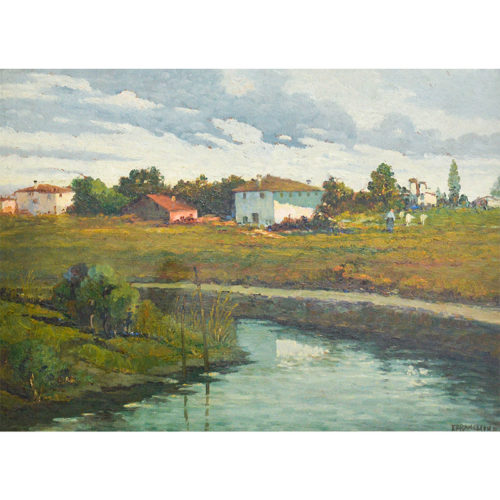 Period: 1940s Measures: In frame H 45 x W 56.5 x D 6 / Painting H 27.5 x L 37 cm"Landscape" - Oil on tablet by Telesforo Franchino (Treviso 1885 - 1968 Turin), dating back to the 1940s. There is no particular biographical information on the painter, however his pictorial testimony remains. He used to paint mountain or simple countryside landscapes. His brush is distinctive and very suggestive.
Period: 1940s Measures: In frame H 45 x W 56.5 x D 6 / Painting H 27.5 x L 37 cm"Landscape" - Oil on tablet by Telesforo Franchino (Treviso 1885 - 1968 Turin), dating back to the 1940s. There is no particular biographical information on the painter, however his pictorial testimony remains. He used to paint mountain or simple countryside landscapes. His brush is distinctive and very suggestive. -
Out of stock
 Period: 1876 Measures: H 93 x L 71 / Canvas H 82 x L 59.5 cm"Still life with woodcock, pheasant and partridge" - Oil on canvas by Michelangelo Meucci (1840-1909), background painted to simulate light ashwood, signed and dated on the lower right "M.Meucci Firenze 1876"
Period: 1876 Measures: H 93 x L 71 / Canvas H 82 x L 59.5 cm"Still life with woodcock, pheasant and partridge" - Oil on canvas by Michelangelo Meucci (1840-1909), background painted to simulate light ashwood, signed and dated on the lower right "M.Meucci Firenze 1876" -
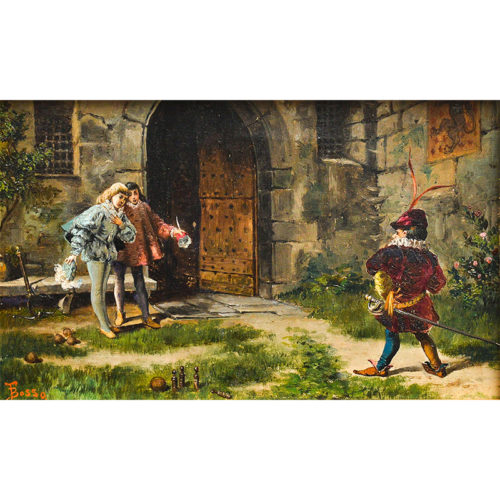 Epoca: Fine '800 Misure: In cornice H 38 x L 46 / Tavola H 16 x L 26,8 cm"The challenge" - Oil on cardboard by Francesco Bosso (1864-1933) BOSSO FRANCESCO. Born in Vercelli on December 27, 1864, died in Turin in 1933. He studied at the Institute of Fine Arts in his city with Bonino and Costa. At the beginning of his artistic career he devoted himself to decoration and scenography, performing several works in palaces, churches and theaters of Italy, France and Switzerland. For the Colonial Exhibition in Genoa he composed a large Diorama of the Panama Canal, appreciated and praised. He especially dedicated himself to the paintings of flowers, fruit and still lifes, which brought him wide fame. In 1922 forty-seven of his paintings were exhibited at the Vercelli Art Exhibition, including: Sun from the glass windows; Rustic rooms in Tournier; Among the rocks; Autumn melancholy; Fontanesian landscape and still lives.
Epoca: Fine '800 Misure: In cornice H 38 x L 46 / Tavola H 16 x L 26,8 cm"The challenge" - Oil on cardboard by Francesco Bosso (1864-1933) BOSSO FRANCESCO. Born in Vercelli on December 27, 1864, died in Turin in 1933. He studied at the Institute of Fine Arts in his city with Bonino and Costa. At the beginning of his artistic career he devoted himself to decoration and scenography, performing several works in palaces, churches and theaters of Italy, France and Switzerland. For the Colonial Exhibition in Genoa he composed a large Diorama of the Panama Canal, appreciated and praised. He especially dedicated himself to the paintings of flowers, fruit and still lifes, which brought him wide fame. In 1922 forty-seven of his paintings were exhibited at the Vercelli Art Exhibition, including: Sun from the glass windows; Rustic rooms in Tournier; Among the rocks; Autumn melancholy; Fontanesian landscape and still lives.
